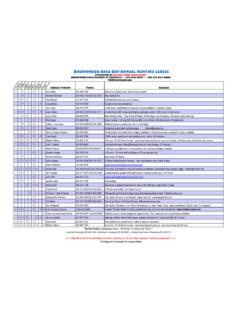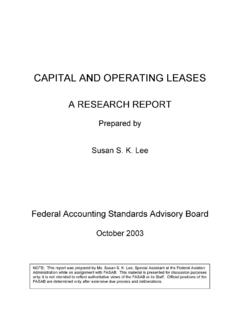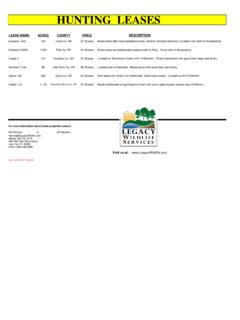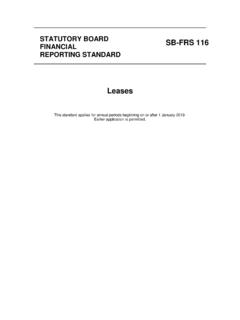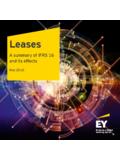Transcription of Accounting for Long term Assets Long Debt AnD …
1 1 1991 2013 NavAcc LLC, G. Peter & Carolyn R. WilsonAccounting for long -term Assets , long -term Debt and LeasesAccounting for long -term Assets , long -term Debt AnD LeAses TABLE OF CONTENTSI ntroduction 2 long -term Assets 2 Acquiring or creating 2 Tangible Assets 2 Intangible Assets 3 Depreciating, amortizing and depleting 3 Impairing and revaluing 5 Disposing 7 long -term Debt 8 Issuing 8 Accruing interest 9 Reclassifying principal 10 Paying interest and principal 10 Leases 11 Classifying leases 12 Measuring initial value of a capital lease 12 Recording entries for leases 13 Proposed updates to leasing standards 152 1991 2013 NavAcc LLC, G.
2 Peter & Carolyn R. WilsonNavigating Accounting INTRODUCTIONThis chapter examines Accounting for long -term Assets , long -term debt, and leases from the perspective of lessees (the company that leases property, plant or equipment from another company called the lessor). The reason we are combining these topics is most of the Accounting and business issues associated with leases are applications of related issues for long -term Assets and long -term debt. long -TERM Assets Accounting for tangible property, plant and equipment (PP&E) and intangible long -term Assets centers on four events: Acquiring or creating Depreciating, amortizing or depleting Impairing and revaluing (revaluations are only allowed under IFRS) DisposingAcquiring or creAtingAccounting for the acquisition or creation of tangible and intangible long -term Assets is similar in many respects, but there are enough differences that we will discuss them separately.
3 Tangible assetsWe will focus our discussion of tangible Assets on PP&E since other tangibles such as natural resources are only important in a few industries. Companies can acquire ownership of PP&E by purchasing it separately with cash or third-party debt financing, acquiring it as part of a business acquisition, or constructing it internally. They can also acquire the right to use PP&E through leasing. When these leases are classified as capital leases, which we will discuss later, they are included in PP&E. Strictly speaking, the leased property is tangible, but the lease itself the right to use the property is an intangible asset . The only significance of this difference is some companies describe the usage of capital leases as depreciation (of a tangible asset ) while others describe it as amortization (of an intangible).
4 We have already studied the entry for purchasing PP&E with cash: increase PP&E and decrease cash for the cost of the purchased asset . Delivery and installation costs are also included in the recognized cost. For purchasing PP&E financed with debt, the entry is similar except debt increases and possibly cash decreases if there s a down payment. For example, here is the entry if Berger Properties acquires a building for $90 million with 100% debt financing (along with land,which is recorded separately):Berger Properties acquires building with 100% debt financingDebitCreditPP&E (historical cost)$90 long -term debt $903 1991 2013 NavAcc LLC, G. Peter & Carolyn R. WilsonAccounting for long -term Assets , long -term Debt and LeasesWhen PP&E is acquired as part of a business acquisition, it is recorded at its fair value the hypothetical price it could be sold for to a third party.
5 When PP&E is constructed internally, it is recorded at the aggregate cost to complete the construction. This includes capitalized interest: a portion of the interest associated with debt that is deemed attributable to the construction (through a formula that is beyond the scope of this chapter).Intangible assetsWhen intangible Assets are purchased from third parties separately with cash or debt financing or as part of a business acquisition, the Accounting is the same as PP&E purchases. This is not true for leasing or creating intangible Assets and the related guidance can be quite different for US GAAP and , US GAAP guidance for leases applies only to PP&E and, in particular, not to intangibles. This means that with one exception the future payments associated with leased intangibles ( , licensing arrangements) can t be capitalized: they are expensed as incurred during the term of the contract.
6 The exception is software leased for internal use. The software can be capitalized if it meets criteria similar to those used to determine whether PP&E leases should be capitalized. In contrast, to US GAAP, IFRS guidance for leases can be applied to many intangible Assets are created through advertising (such as brands) or basic research, the R in R&D, (such as intellectual property) with one exception, these Assets can t be recognized on balance sheets under US GAAP and IFRS. This is because standard setters have concluded they can t be measured reliably. Thus, costs associated with research are always expensed as incurred. However, the one exception under US GAAP is the costs to develop advertisements: costs can be capitalized until the advertisements are first used, at which time costs are expensed.
7 When intangible Assets are created through development, the D in R&D, with a few exceptions, the costs associated with the development are also expensed as incurred under US GAAP. The exceptions that are most prevalent center on costs associated with software development. Software developed for internal use and software developed to be sold to customers can both be capitalized, but the criteria differ. By contrast, under IFRS costs associated with internally developing any intangible must be capitalized once the development process is far enough along so six criteria are met. These criteria establish that it is probable the intangible will meet its intended purpose; the company is committed to using or selling it; and the remaining development costs can be estimated reliably.
8 This difference in Accounting guidance under US GAAP and IFRS can significantly affect financial-statement comparisons of global competitors. For example, at year end December 31, 2012, Daimler reported billion euros of capitalized development costs under IFRS. These costs would have been previously expensed if Daimler reported under US GAAP. DepreciAting, Amortizing AnD DepLetingDepreciation, amortization, and depletion measure the portion of an asset s historical cost allocated to usage or the passage of time during the asset s useful life. Throughout the world, depletion refers to using up natural resources. In some countries, including the US, depreciation generally refers to using up tangible Assets and amortization to using up intangible Assets . In other countries, however, amortization is a synonym for depreciation.
9 4 1991 2013 NavAcc LLC, G. Peter & Carolyn R. WilsonNavigating Accounting Aside from these differences in terms , the entries for using up PP&E, intangible Assets , or natural resources are structurally the same. For example, to record depreciation expense, we increase the expense and increase accumulated depreciation. To record amortization expense, we increase the expense and increase accumulated amortization. These are the only depreciation and amortization entries for companies that don t manufacture the products they sell. Manufacturing companies have two types of long -term Assets : (i) production-related long -term Assets such as manufacturing equipment, factories and intellectual property associated with production and (ii) non-production-related long -term Assets such as the corporate headquarters and administrative computers.
10 The depreciation and amortization entries are quite different for non-production asset types. However, these differences can easily be understood using the four questions and OEC Map approach we have been using throughout the course to record entries. We will first demonstrate this approach for depreciation associated with non-production-related PP&E. The resulting depreciation entry will be the one you have recorded often in earlier chapters: increase depreciation expense and increase accumulated depreciation. That is, all along we have been depreciating non-production-related Assets . Recall our responses to the four questions: 1. Should an asset be recognized? Generally, we would expect future benefits to be created when a company uses non-production-related Assets . For example, we would expect future benefits to be realized when sales staff use company cars to see customers or employees at the corporate headquarters use computers.

